Cervical Lymph Nodes as a Selective Niche for Brucella during Oral Infections
- PMID: 25919005
- PMCID: PMC4412401
- DOI: 10.1371/journal.pone.0121790
Cervical Lymph Nodes as a Selective Niche for Brucella during Oral Infections
Abstract
Cervical lymph nodes (CLN) are the first lymph nodes encountered by material taking the oral route. To study their role in orally acquired infections, we analyzed 307 patients of up to 14 years treated in the university clinic of Skopje, Macedonia, for brucellosis, a zoonotic bacterial disease frequently acquired by ingestion of contaminated dairy products. From these children, 36% had lymphadenopathy. Among orally infected children, lymphadenopathy with CLN being the only lymph nodes affected was significantly more frequent as compared to those infected by contact with animals (83% vs. 63%), suggesting a possible involvement of CLN during orally acquired human brucellosis. Using a murine model where bacteria are delivered into the oral cavity, we show that Brucella quickly and selectively colonize the CLN where they proliferate and persist over long periods of time for up to 50 days post-infection. A similar efficient though less specific drainage to CLN was found for Brucella, Salmonella typhimurium and fluorescent microspheres delivered by gavage, a pathway likely representing a mixed infection mode of intragastric and oral infection, suggesting a central pathway of drained material. Microspheres as well as bacteria drained to CLN predominately reside in cells expressing CD68 and no or low levels of CD11c. Even though no systemic response could be detected, Brucella induced a locally restricted inflammatory reaction with increased expression levels of interferon γ, interleukin (IL)-6, IL-12, granzyme B and a delayed induction of Nos2. Inflammation led to pronounced lymphadenopathy, infiltration of macrophages/monocytes expressing high levels of major histocompatibility complex II and to formation of epitheloid granulomas. Together, these results highlight the role of CLN in oral infections as both, an initial and efficient trap for bacterial invaders and as possible reservoir for chronic pathogens. They likewise cast a new light on the significance of oral routes for means of vaccination.
Conflict of interest statement
Figures
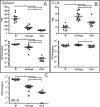

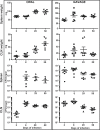

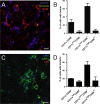

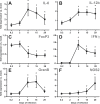
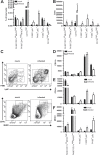

Similar articles
-
A review of the immunopathogenesis of Brucellosis.Infect Dis (Lond). 2019 May;51(5):321-333. doi: 10.1080/23744235.2019.1568545. Epub 2019 Feb 18. Infect Dis (Lond). 2019. PMID: 30773082 Review.
-
The innate immune response against Brucella in humans.Vet Microbiol. 2002 Dec 20;90(1-4):383-94. doi: 10.1016/s0378-1135(02)00223-7. Vet Microbiol. 2002. PMID: 12414158 Review.
-
In situ microscopy analysis reveals local innate immune response developed around Brucella infected cells in resistant and susceptible mice.PLoS Pathog. 2012;8(3):e1002575. doi: 10.1371/journal.ppat.1002575. Epub 2012 Mar 29. PLoS Pathog. 2012. PMID: 22479178 Free PMC article.
-
Nasal vaccination stimulates CD8(+) T cells for potent protection against mucosal Brucella melitensis challenge.Immunol Cell Biol. 2016 May;94(5):496-508. doi: 10.1038/icb.2016.5. Epub 2016 Jan 11. Immunol Cell Biol. 2016. PMID: 26752510 Free PMC article.
-
What have we learned from brucellosis in the mouse model?Vet Res. 2012 Apr 13;43(1):29. doi: 10.1186/1297-9716-43-29. Vet Res. 2012. PMID: 22500859 Free PMC article. Review.
Cited by
-
Brucella neotomae Recapitulates Attributes of Zoonotic Human Disease in a Murine Infection Model.Infect Immun. 2018 Dec 19;87(1):e00255-18. doi: 10.1128/IAI.00255-18. Print 2019 Jan. Infect Immun. 2018. PMID: 30373892 Free PMC article.
-
Emerging and re-emerging infectious disease in otorhinolaryngology.Acta Otorhinolaryngol Ital. 2018 Apr;38(SUPPL. 1):S1-S106. doi: 10.14639/0392-100X-suppl.1-38-2018. Acta Otorhinolaryngol Ital. 2018. PMID: 29967548 Free PMC article. Review.
-
Systems Biology Analysis of Temporal In vivo Brucella melitensis and Bovine Transcriptomes Predicts host:Pathogen Protein-Protein Interactions.Front Microbiol. 2017 Jul 27;8:1275. doi: 10.3389/fmicb.2017.01275. eCollection 2017. Front Microbiol. 2017. PMID: 28798726 Free PMC article.
-
Leucocyte Trafficking via the Lymphatic Vasculature- Mechanisms and Consequences.Front Immunol. 2019 Mar 14;10:471. doi: 10.3389/fimmu.2019.00471. eCollection 2019. Front Immunol. 2019. PMID: 30923528 Free PMC article. Review.
-
Route of Infection Strongly Impacts the Host-Pathogen Relationship.Front Immunol. 2019 Jul 11;10:1589. doi: 10.3389/fimmu.2019.01589. eCollection 2019. Front Immunol. 2019. PMID: 31354728 Free PMC article.
References
-
- Dasaraju PV, Liu C. Infections of the Respiratory System. In: Baron S, editor. Medical Microbiology. 4th ed. Galveston (TX); 1996. - PubMed
-
- Hamrah P, Dana MR. Corneal antigen-presenting cells. Chem Immunol Allergy 2007;92: 58–70. - PubMed
-
- Kida S, Pantazis A, Weller RO. CSF drains directly from the subarachnoid space into nasal lymphatics in the rat. Anatomy, histology and immunological significance. Neuropathol Appl Neurobiol 1993;19: 480–488. - PubMed
-
- Wolvers DA, Coenen-de Roo CJ, Mebius RE, van der Cammen MJ, Tirion F, et al. Intranasally induced immunological tolerance is determined by characteristics of the draining lymph nodes: studies with OVA and human cartilage gp-39. J Immunol 1999;162: 1994–1998. - PubMed
Publication types
MeSH terms
Substances
LinkOut - more resources
Full Text Sources
Other Literature Sources
Medical
Research Materials
Miscellaneous

